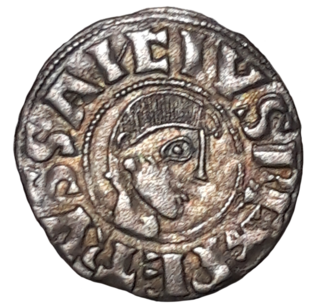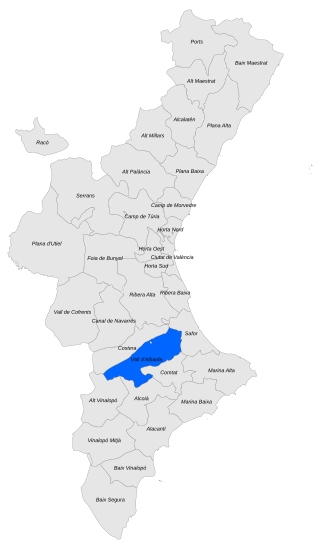
Pope Alexander VI was head of the Catholic Church and ruler of the Papal States from 11 August 1492 until his death in 1503. Born into the prominent Borgia family in Xàtiva in the Kingdom of Valencia under the Crown of Aragon, Rodrigo studied law at the University of Bologna. He was ordained deacon and made a cardinal in 1456 after the election of his uncle as Pope Callixtus III, and a year later he became vice-chancellor of the Catholic Church. He proceeded to serve in the Curia under the next four popes, acquiring significant influence and wealth in the process. In 1492, Rodrigo was elected pope, taking the name Alexander VI.

Pope Callixtus III, born Alfonso de Borgia, was head of the Catholic Church and ruler of the Papal States from 8 April 1455 to his death, in August 1458.

Peter I was King of Aragon and also Pamplona from 1094 until his death in 1104. Peter was the eldest son of Sancho Ramírez, from whom he inherited the crowns of Aragon and Pamplona, and Isabella of Urgell. He was named in honour of Saint Peter, because of his father's special devotion to the Holy See, to which he had made his kingdom a vassal. Peter continued his father's close alliance with the Church and pursued his military thrust south against bordering Al-Andalus taifas with great success, allying with Rodrigo Díaz de Vivar, known as El Cid, the ruler of Valencia, against the Almoravids. According to the medieval Annales Compostellani Peter was "expert in war and daring in initiative", and one modern historian has remarked that "his grasp of the possibilities inherent in the age seems to have been faultless."

The House of Borgia was a Spanish noble family, which rose to prominence during the Italian Renaissance. They were from Xàtiva, Kingdom of Valencia, the surname being a toponymic from the town of Borja, then in the Crown of Aragon, in Spain.

Xàtiva is a town in eastern Spain, in the province of Valencia, on the right (western) bank of the river Albaida and at the junction of the Valencia–Murcia and Valencia Albacete railways. It is located 25 km west of the Mediterranean Sea. During the Al-Andalus Islamic era, Arabs brought the technology to manufacture paper to Xàtiva. In the 12th century, Xàtiva was known for its schools, education, and learning circles. Islamic scholar Abu Ishaq al-Shatibi's last name refers to Xàtiva where he lived and died. After the Reconquista by Northern Christian kingdoms and the following Christian repopulation, the city became the cradle of one of the most powerful and controversial families of the Renaissance, the House of Borgia, which produced Popes like Callixtus III and Alexander VI.

La Costera is a comarca in the province of Valencia, Valencian Community, Spain.

Vall d'Albaida is a comarca in the province of Valencia, Valencian Community, Spain.

María Alfonso Téllez de Meneses, known as María de Molina, was queen consort of Castile and León from 1284 to 1295 by marriage to Sancho IV of Castile, and served as regent for her minor son Ferdinand IV and later her grandson Alfonso XI of Castile (1312-1321).

Castielfabib is a municipality in the comarca of Rincón de Ademuz in the Valencian Community, Spain.

The Marquisate of Cenete is a noble title first granted in 1491 by Queen Isabel I of Castile to Rodrigo Díaz de Vivar y Mendoza, First Count del Cid.

Alfonso de la Cerda,, called "the Disinherited", was the elder son of Ferdinand de la Cerda and his wife Blanche of France, and was a grandson of Alfonso X of Castile. Alfonso and his brother Fernando were candidates for the Castilian-Leonese crown during the reigns of Sancho IV of Castile, Ferdinand IV of Castile and Alfonso XI of Castile. In 1331, Alfonso renounced his rights and swore allegiance to Alfonso XI of Castile.
Juan Domingo de Borja y Doncel was the father of future Pope Callixtus III. He held the title over the Barony La Torre de Canals. He was a member of the House of Borja.

The Route of the Borgias is a cultural route, that includes sites associated with the Borja or Borgia, located in their native Valencian Community, Spain. The marketing of the route was inaugurated in 2007.

The Tower and walls of the Borgias of the Valencian municipality of Canals (Spain), is a Bien de Interés Cultural with the code 46.23.081-003 and Ministerial annotation R-I-51-0010524 with date April 3, 2000. Is also known in valencian as Torreta de Canals.
The Hermitage of Santa Anna is a religious building located in the surroundings of Xàtiva (València), Spain, built in the 15th century.
The Lordship of Torre de Canals was a lordship in the Crown of Aragon located in and around the town of Torre de Canals. The town is located in the present day Valencian Community and no longer exists as a lordship.

The central comarques of the Valencian Community, or Valencian Country, is a region of the Valencia Autonomous Community conterminous with the historical territory of the Governor of Xàtiva and the Province of Xàtiva. In modern times it comprises the comarques of Costera, Canal de Navarres, Vall d'Albaida, Marina, Comtat and Alcoià.
Denis of Hungary, was a Hungarian-born Aragonese knight and nobleman in the 13th century. Born into a prominent family in the Kingdom of Hungary, he escorted Queen Violant of Hungary to the Kingdom of Aragon in 1235, where he settled down and faithfully served James I of Aragon during the Reconquista. Integrating into the local elite, Denis was the eponymous ancestor of the prominent Dionís (Dionisii) noble family. In Canals, Valencia, a street is named after him.

The C-2 commuter line of Cercanías Valencia covers a distance of 84 km across the province of Valencia in the Valencian Community, Spain, between Valencia Nord and Moixent. It serves the municipalities of Valencia, Alfafar, Benetússer, Massanassa, Catarroja, Silla, Benifaió, Almussafes, Algemesí, Alzira, Carcaixent, La Pobla Llarga, Manuel, L'Ènova, Xátiva, L'Alcúdia de Crespins, Montesa, Vallada, and Moixent.


















